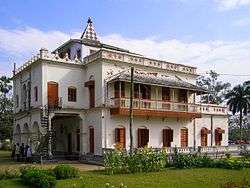Shilaidaha
Shilaidaha Kuthibadi [1][2] (Bengali: শিলাইদহ) is a place in Kumarkhali Upazila of Kushtia District in Bangladesh. The place is famous for Kuthi Bari; a country house made by Dwarkanath Tagore.[3] Rabindranath Tagore lived a part of life here and created some of his memorable poems while living here.[4] The geographic location of this place is 23°55'11.48"N, 89°13'12.11"E.

Shelaidaha Kuthi Bari
In 1890 Tagore started managing their family estates in Shelaidaha. He stayed there for over a decade at irregular intervals between 1891 and 1901. It is a country house built by the father of Rabindranath, Maharshi Debendranath Tagore. The house was repossessed by a Bank; the Tagore Estate was a debtor to this Bank, who auctioned off the property and it became the possession of the Zamindar of Bhagyakul (Munshiganj), Roy family. The house was part of Roy Estate till the Zamindari system was abolished under the East Bengal State Acquisition and Tenancy Act of 1950. Syed Murtaza Ali, during his tenure as Divisional Commissioner of Rajshahi took the initiative to preserve the dilapidated house in 1958. During this renovation, the color of the house was inadvertently changed to red like other houses belonged to the former Zamindars of the district.
Literature
During his stay he wrote many of his famous poems, essays and short stories there. Among those some of the masterpieces are Sonar Tari, Katha o Kahini, Chitra, Chaitali, etc. He also translated many of his creations in English there. He also wrote most of the poems from Naibedya, Kheya and many of the songs from Gitanjali and Geetimalya. It was here, in Shelaidaha in 1912, that he started translating his Gitanjali into English, which earned him the Nobel Prize for literature in 1913. [5][6]
Architecture
It is a three storied building constructed with brick, timber, corrugated tin sheets etc. The building is pyramid shaped with a terrace. The total area of the compound is 11 acres. The building is situated on right in the middle of the compound.[5]
Museum
The reformation of Kuthi Bari has been completed under the Department of Archaeology, Ministry of Cultural Affairs. It now serves as a museum named 'Tagore Memorial Museum'. Many of the objects Tagore used are displayed here, such as his bed, wardrobe, iron chest, lawn mower, framed pictures and last but not the least his houseboat.[5][7]
Festivals
Several festivals are observed throughout the year in Kuthi Bari such as 25th Baishakh as Tagore's birth anniversary. It is a five-day-long festival. People from across the country as well as India and the rest of the world join this occasion to celebrate his birthday. The program includes discussion, cultural program, fair and staging of his plays.[4]
Gallery
 Shilaidaha Kuthibadi in 2015
Shilaidaha Kuthibadi in 2015 Shilaidaha Kuthibadi Complex in 2015
Shilaidaha Kuthibadi Complex in 2015 Indside of Shilaidaha Kuthibadi in 2015
Indside of Shilaidaha Kuthibadi in 2015- Shilaidaha Kuthibadi in 2008
- Shilaidaha Kuthibadi 2008
 Another View of Shilaidaha Kuthibadi (2015)
Another View of Shilaidaha Kuthibadi (2015)- Shilaidaha Kuthibadi in 2008
- Pond in Shelaidaha Kuthibari premises (2008)
- Shops for traveller's in front of Shelaidaha kuthibari (2008)
 Replica of boat used by Rabindranath Tagore, reserved at the pond of Shelaidaha kuthibari. (2016)
Replica of boat used by Rabindranath Tagore, reserved at the pond of Shelaidaha kuthibari. (2016)
See also
- Rabindra Bharati Museum, at Jorasanko Thakur Bari, Kolkata, India
- Rabindra Bhaban Museum, Santiniketan, India
References
- "Shilaidaha Kuthibari: Out of focus By Ershad Kamol". www.kumarkhali.com. Archived from the original on 13 July 2011. Retrieved 29 December 2010.
- "Kuthibari of Rbindranath". The Kushtia Times. Retrieved 29 December 2010.
- "Bangladesh Parjatan Corporation". Parjatan.gov.bd. 14 April 1971. Archived from the original on 14 February 2012. Retrieved 10 October 2012.
- Aman, Amanur (15 May 2012). "Celebration at Shelaidaha Kuthibari". The Daily Star. Retrieved 10 October 2012.
- Islam, P. M. Serajul (10 April 2013). "Rabindrnath's Kuthibari - The Glorious Tourist Attraction". Banglanews24.com. Archived from the original on 1 November 2013. Retrieved 30 October 2013.
- Kenneth Schouler (30 September 2010). The Everything Hinduism Book: Learn the traditions and rituals of the "religion of peace". Adams Media. pp. 189–. ISBN 978-1-4405-2213-0. Retrieved 10 October 2012.
- The Telegraph. Varsities to showcase replicas of Tagore boats 21 June 2012.
External links
| Wikimedia Commons has media related to Shilaidaha. |
| Wikimedia Commons has media related to Shilaidaha Kuthibadi. |
- Shilaidaha Kuthibadi at banglapedia